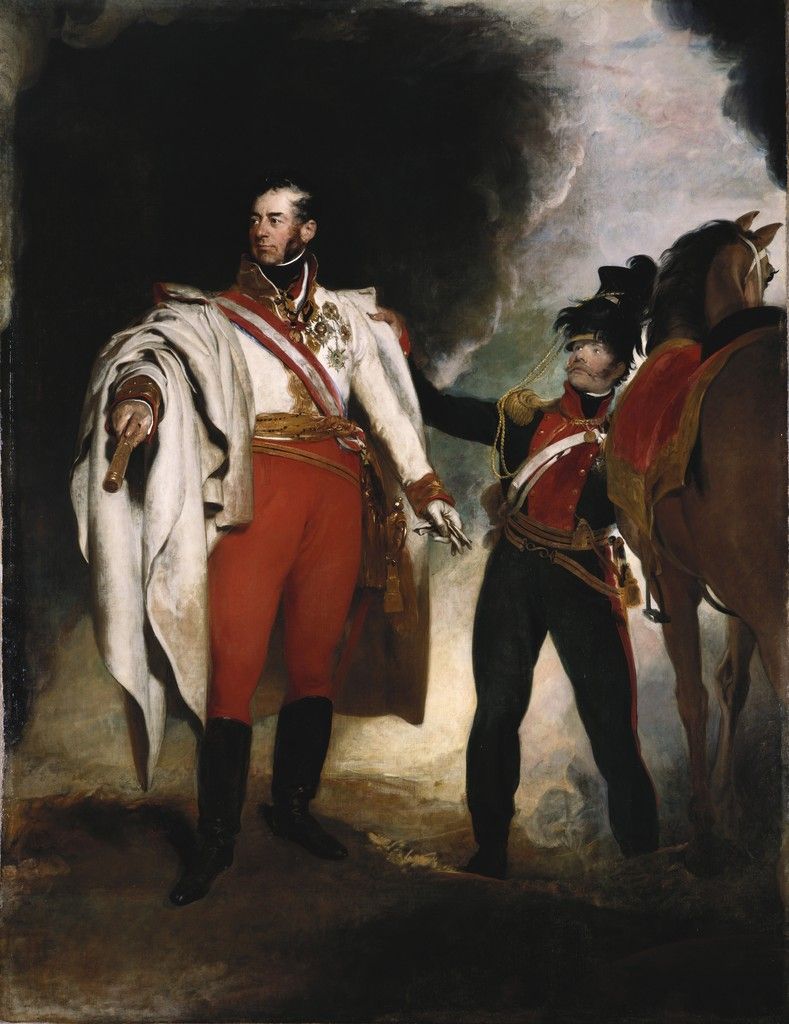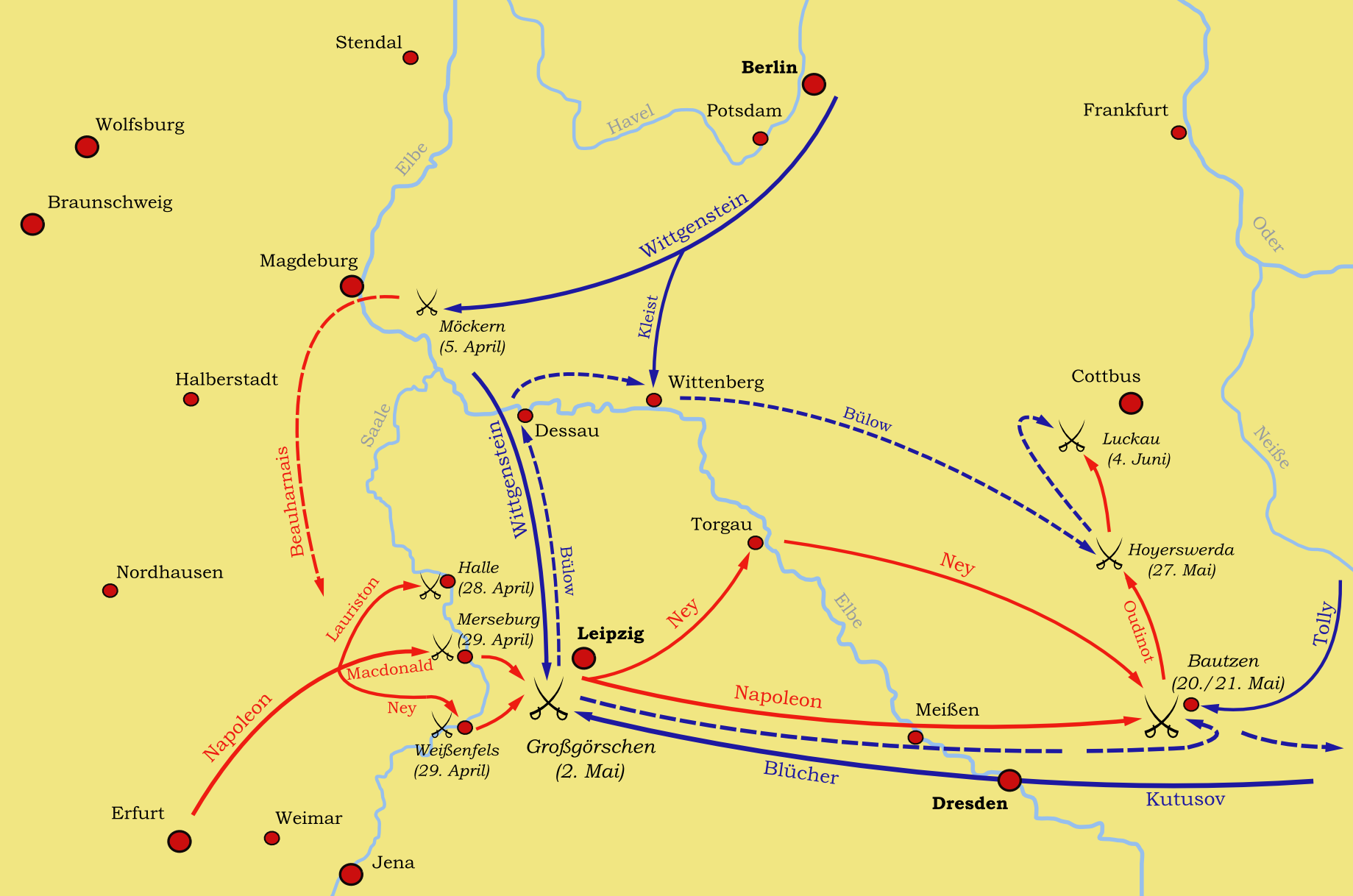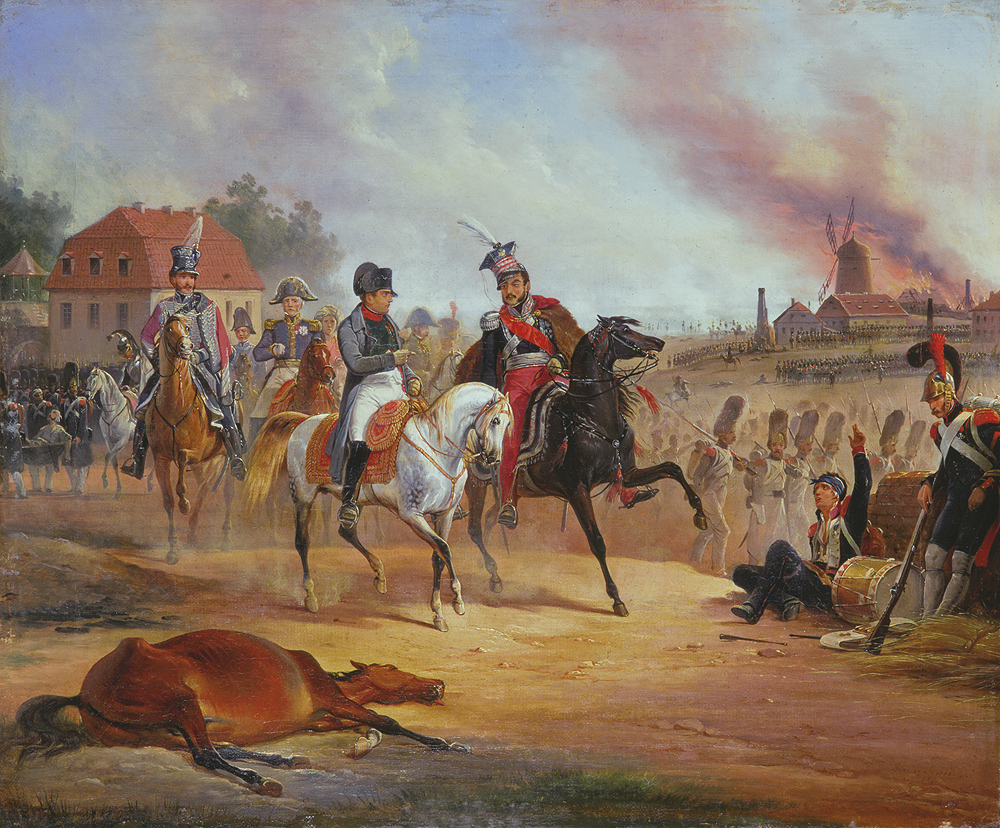|
Friedrich Karl Gustav Freiherr Von Langenau
Friedrich Karl Gustav Freiherr von Langenau, Imperial Field Marshal-Lieutenant, (7 November 1782, in Dresden - 4 July 1840 Gratz) was Quartermaster-General of the Grand Army of Bohemia, in 1814, and Austrian Army of the Upper Rhine, under Schwarzenberg in 1815. Early life He was the son of a Saxon lieutenant General, Gottlob Bernhard. He joined at the age of 13 years in the Saxon army, as a Unterleutnant, in the "Kurfürst" Infantry Regiment. He participated in the campaigns of 1796 to 1812, including the Battle of Saalfeld. Notably, in the Russian Campaign in 1812, he was head of the General Staff of the VII (Saxon) Corps. After the return of the Saxon Corps from Russia, the King appointed him Adjutant-General. In 1813 he negotiated a treaty for mutual defence with Austria; but after the Battle of Lützen (1813), the king of Saxony returned to the French fold at Dresden. Langenau resigned and fought for Austria. On 27 July 1813, Langenau was Major General to the General S ... [...More Info...] [...Related Items...] OR: [Wikipedia] [Google] [Baidu] |
Minor Campaigns Of 1815
On 1 March 1815 Napoleon Bonaparte escaped from his imprisonment on the isle of Elba, and launched a bid to recover his empire. A confederation of European powers pledged to stop him. During the period known as the Hundred Days Napoleon chose to confront the armies of Prince Blücher and the Duke of Wellington in what has become known as the Waterloo Campaign. He was decisively defeated by the two allied armies at the Battle of Waterloo, which then marched on Paris forcing Napoleon to abdicate for the second time. However Russia, Austria and some of the minor German states also fielded armies against him and all of them also invaded France. Of these other armies the ones engaged in the largest campaigns and saw the most fighting were two Austrian armies: The Army of the Upper Rhine and the Army of Italy. The Battle of Waterloo, followed as it was by the advance of the armies of Blücher and Wellington upon Paris, was so decisive in its effects, and so comprehensive in its results, ... [...More Info...] [...Related Items...] OR: [Wikipedia] [Google] [Baidu] |
Karl Philipp, Prince Of Schwarzenberg
Karl Philipp, Fürst zu Schwarzenberg (or Charles Philip, Prince of Schwarzenberg; 18/19 April 1771 – 15 October 1820) was an Austrian Generalissimo. He fought in the Battle of Wagram (1809) but the Austrians lost decisively against Napoleon. He had to fight for Napoleon in the Battle of Gorodechno (1812) against the Russians and won. He was in command of the allied army that defeated Napoleon decisively in the Battle of Leipzig (1813). He joined the Battle of Paris (1814) that forced Napoleon to abdicate. Family Karl Philipp was born 18/19 April 1771 in Vienna, the son of Johann Nepomuk Anton of Schwarzenberg and Marie Eleonore Countess of Öttingen-Wallerstein. He was one of thirteen siblings, seven of whom did not reach adulthood.''Biographisches Lexikon des Kaiserthums Oesterreich,'' Band: 33 (1877), ab Seite: 82. Imperial service Karl Philipp entered the imperial cavalry in 1788, fought in 1789 under Lacy and Laudon against the Turks, distinguished himself by hi ... [...More Info...] [...Related Items...] OR: [Wikipedia] [Google] [Baidu] |
Battle Of Saalfeld
The Battle of Saalfeld took place on 10 October 1806, at which a French force of 12,800 men commanded by Marshal Jean Lannes defeated a Prussian- Saxon force of 8,300 men under Prince Louis Ferdinand. The battle took place in Thuringia in what was the Ernestine duchy of Saxe-Coburg-Saalfeld. The battle was the second clash in the Prussian Campaign of the War of the Fourth Coalition. Background French Movements Napoleon had arranged the Grande Armée into three columns to cross the Thuringian Forest to attack the Prussian-Saxon army. The westernmost column was headed by V Corps commanded by Jean Lannes, with Pierre Augereau's VII Corps following behind. They had orders to march from Coburg via Gräfenthal due at Saalfeld on 11 October. V Corps set out on 8 October, and by the end of 9 October was at Gräfenthal with light cavalry on the road to Saalfeld. At 5am on 10 October, Lannes with Louis-Gabriel Suchet's division and Anne-François-Charles Trelliard brigade of ligh ... [...More Info...] [...Related Items...] OR: [Wikipedia] [Google] [Baidu] |
Battle Of Lützen (1813)
In the Battle of Lützen (German: ''Schlacht von Großgörschen'', 2 May 1813), Napoleon I of France defeated an allied army of the Sixth Coalition. The Russian commander, Prince Peter Wittgenstein, attempting to forestall Napoleon's capture of Leipzig, attacked the French right wing near Lützen, Saxony-Anhalt, Germany, surprising Napoleon. Quickly recovering, he ordered a double envelopment of the allies. After a day of heavy fighting, the imminent encirclement of his army prompted Wittgenstein to retreat. Due to a shortage of cavalry, the French did not pursue. The next battle would be fought at Bautzen three weeks later. Prelude Following the disaster of French invasion of Russia in 1812, a new Coalition consisting of Britain, Sweden, Prussia and Russia formed against France. In response to this, Napoleon hastily assembled an army of just over 200,000 which included inexperienced recruits, troops from Spain and garrison battalions but was severely short of horses (a co ... [...More Info...] [...Related Items...] OR: [Wikipedia] [Google] [Baidu] |
Frederick Augustus III, Elector Of Saxony
pl, Fryderyk August Józef Maria Antoni Jan Nepomucen Alojzy Ksawery , image = Frederick Augustus I of Saxony by Marcello Bacciarelli (ca 1808-1809).png , caption = Portrait by Marcello Bacciarelli (1809) , succession = King of Saxony , coronation = 20 December 1806 , reign = , successor = Anthony , regent = Maria Antonia of Bavaria , succession1 = Grand Duke of the Duchy of Warsaw , reign1 = 9 June 1807 – 22 May 1815 , succession2 = Elector of Saxony , reign2 = 17 December 1763 – , predecessor2 = Frederick Christian , spouse=Amalie of Zweibrücken-Birkenfeld , issue= Princess Maria Augusta of Saxony , house= Wettin , father=Frederick Christian, Elector of Saxony , mother= Princess Maria Antonia of Bavaria , birth_date = , birth_place = Dresden, Electorate of Saxony, Holy Roman Empire , death_date = , death_place = Dresden, Kingdom of Saxony, German Confederation , place of burial=Dresden Cathedral, Dresden , religion= Roman Catholicism , signatu ... [...More Info...] [...Related Items...] OR: [Wikipedia] [Google] [Baidu] |
Battle Of Dresden
The Battle of Dresden (26–27 August 1813) was a major engagement of the Napoleonic Wars. The battle took place around the city of Dresden in modern-day Germany. With the recent addition of Austria, the Sixth Coalition felt emboldened in their quest to expel the French from Central Europe. Despite being heavily outnumbered, French forces under Napoleon scored a victory against the Army of Bohemia led by Generalissimo Karl von Schwarzenberg. However, Napoleon's victory did not lead to the collapse of the coalition, and the weather and the uncommitted Russian reserves who formed an effective rear-guard precluded a major pursuit. Three days after the battle, the Allies surrounded and destroyed a French corps advancing into their line of withdrawal at the Battle of Kulm. Prelude On the 16 August, Napoleon had sent Marshal Saint-Cyr's corps to fortify and hold Dresden in order to hinder allied movements and to serve as a possible base for his own manoeuvres. He planned to str ... [...More Info...] [...Related Items...] OR: [Wikipedia] [Google] [Baidu] |
Battle Of Leipzig
The Battle of Leipzig (french: Bataille de Leipsick; german: Völkerschlacht bei Leipzig, ); sv, Slaget vid Leipzig), also known as the Battle of the Nations (french: Bataille des Nations; russian: Битва народов, translit=Bitva narodov), was fought from 16 to 19 October 1813 at Leipzig, Saxony. The Coalition armies of Austria, Prussia, Sweden, and Russia, led by Tsar Alexander I and Karl von Schwarzenberg, decisively defeated the '' Grande Armée'' of French Emperor Napoleon Bonaparte. Napoleon's army also contained Polish and Italian troops, as well as Germans from the Confederation of the Rhine (mainly Saxony and Württemberg). The battle was the culmination of the German Campaign of 1813 and involved 560,000 soldiers, 2,200 artillery pieces, the expenditure of 400,000 rounds of artillery ammunition, and 133,000 casualties, making it the largest battle in Europe prior to World War I. Decisively defeated again, Napoleon was compelled to return to France while ... [...More Info...] [...Related Items...] OR: [Wikipedia] [Google] [Baidu] |
Wachau
The Wachau () is an Austrian valley with a picturesque landscape formed by the Danube river. It is one of the most prominent tourist destinations of Lower Austria, located midway between the towns of Melk and Krems that also attracts "connoisseurs and epicureans" for its high-quality wines. It is in length and was already settled in prehistoric times. A well-known place and tourist attraction is Dürnstein, where King Richard the Lionheart of England was held captive by Duke Leopold V of Austria and Styria. The architectural elegance of its ancient monasteries (Melk Abbey and Göttweig Abbey), castles and ruins combined with the urban architecture of its towns and villages, and the cultivation of vines as an important agricultural produce are the dominant features of the valley. The Wachau was inscribed as "Wachau Cultural Landscape" in the UNESCO List of World Heritage Sites in recognition of its architectural and agricultural history, in December 2000. History Ancient his ... [...More Info...] [...Related Items...] OR: [Wikipedia] [Google] [Baidu] |
Hochheim Am Main
Hochheim am Main (; Old English: Hockamore) is a town in the Main-Taunus district of the German state of Hesse. It is located near the right bank of the river Main three miles above its confluence with the Rhine, as well as on the German Timber-Frame Road. Geography Location Located in the Rheingau, Hochheim has historically been a centre of the wine trade. The English word "hock", a generic term for Rhine wine, is derived from Hochheim. History There is a historical reference to Hochheim in the chronicles as early as the 7th century. Hochheim is the site of an Austrian military victory over the French Empire on 7 November 1813. image:Hochheim_Suedstadt_2005_08_13.jpg, South of Hochheim am Main Town partnerships Hochheim has the following twinned towns: * Le Pontet, France since 1987 * Bonyhád, Hungary since 1997 * Kölleda Education Local children attend school in Hochheim until the Year 11 (UK) or 10th grade (US). After that, if they choose to continue with their edu ... [...More Info...] [...Related Items...] OR: [Wikipedia] [Google] [Baidu] |
Joseph Radetzky Von Radetz
Johann Josef Wenzel Anton Franz Karl, Graf Radetzky von Radetz ( en, John Joseph Wenceslaus Anthony Francis Charles, Count Radetzky of Radetz; cz, Jan Josef Václav Antonín František Karel hrabě Radecký z Radče; sl, Janez Jožef Vencelj Anton Frančišek Karel grof Radetzky; 2 November 1766 – 5 January 1858) was a Czech nobleman and Austrian field marshal. He served as chief of the general staff in the Habsburg monarchy during the later period of the Napoleonic Wars and afterwards began military reforms. A disciplined and fair man, he was so beloved by his troops that he was known as ''Vater'' ('Father') Radetzky. He is best known for the victories at the Battles of Custoza (24–25 July 1848) and Novara (23 March 1849) during the First Italian War of Independence. Early years Radetzky, a titled ''Graf'' ('Count'), was born into a noble Bohemian military family of Czech origin at Chateau Třebnice (german: Trebnitz) near Sedlčany in Bohemia (now part of the town) ... [...More Info...] [...Related Items...] OR: [Wikipedia] [Google] [Baidu] |
Bundesversammlung (German Confederation)
The Federal Convention (or ''Confederate Diet'' german: Bundesversammlung or Bundestag) was the only central institution of the German Confederation (german: Deutscher Bund) from 1815 until 1848, and from 1850 until 1866. The Federal Convention had its seat in the ''Palais Thurn und Taxis'' in Frankfurt. It was organized as a permanent congress of envoys of the member states. Origin The German Confederation and its Diet came into existence as a result of the Congress of Vienna in 1815 after the defeat of Napoleon. The original task was to create a new constitutional structure for Germany after the dissolution of the Holy Roman Empire eight years before. The princes of the German states wanted to keep their sovereignty, therefore the German Confederation was created as a loose confederation of independent monarchist states, but included four free cities as well. The founding act was the '' German Federal Act'' of June 8, 1815 (German: ''Deutsche Bundesakte'' [...More Info...] [...Related Items...] OR: [Wikipedia] [Google] [Baidu] |
Frankfurt Am Main
Frankfurt, officially Frankfurt am Main (; Hessian: , "Frank ford on the Main"), is the most populous city in the German state of Hesse. Its 791,000 inhabitants as of 2022 make it the fifth-most populous city in Germany. Located on its namesake Main River, it forms a continuous conurbation with the neighboring city of Offenbach am Main and its urban area has a population of over 2.3 million. The city is the heart of the larger Rhine-Main metropolitan region, which has a population of more than 5.6 million and is Germany's second-largest metropolitan region after the Rhine-Ruhr region. Frankfurt's central business district, the Bankenviertel, lies about northwest of the geographic center of the EU at Gadheim, Lower Franconia. Like France and Franconia, the city is named after the Franks. Frankfurt is the largest city in the Rhine Franconian dialect area. Frankfurt was a city state, the Free City of Frankfurt, for nearly five centuries, and was one of the most import ... [...More Info...] [...Related Items...] OR: [Wikipedia] [Google] [Baidu] |


_-_Le_maréchal_Lannes_(1769-1809)%2C_1834.jpg)


.jpg)

